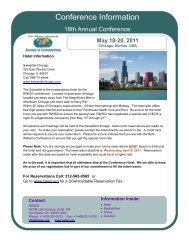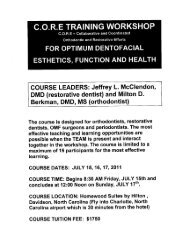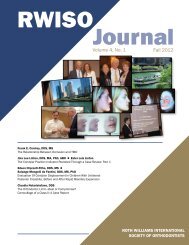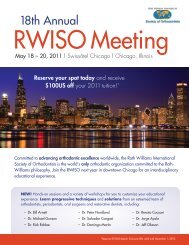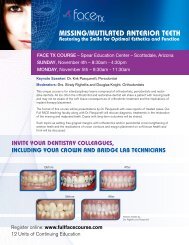2010 RWISO Journal - Roth Williams International Society of ...
2010 RWISO Journal - Roth Williams International Society of ...
2010 RWISO Journal - Roth Williams International Society of ...
You also want an ePaper? Increase the reach of your titles
YUMPU automatically turns print PDFs into web optimized ePapers that Google loves.
Subtractive coronaplasty 15 was done on the posterior<br />
teeth to achieve equal stops and maximum intercuspation in<br />
SCP, and to preserve the natural tooth forms (Figure 16).<br />
Figure 16 Before and after coronaplasty.<br />
Figure 16-a The maxillary arch after coronaplasty shows<br />
that coronaplasty does not necessarily flatten the occlusal<br />
surfaces. Rather, it can redefine the anatomy.<br />
Figure 16-b The mandibular arch after coronaplasty also<br />
shows redefined anatomic form <strong>of</strong> the posterior teeth.<br />
Anterior maxillary and mandibular teeth were built up<br />
with wax on the diagnostic casts to relegate all eccentric<br />
tooth contacts to the anterior teeth (Figure 17).<br />
The additive coronaplasty was done by duplicating the<br />
wax-up <strong>of</strong> the casts on the anterior teeth with composite<br />
resin (Figure 18). 16<br />
Figure 17 Wax-up on the mounted model to achieve 3 mm to 4<br />
mm <strong>of</strong> vertical overbite and 2 mm to 3 mm <strong>of</strong> horizontal overjet.<br />
Figure 18 Additive coronaplasty was done with a hybrid-type<br />
composite resin on each anterior tooth according to the<br />
wax-up in Figure 12.<br />
66 Linton, Jung | The Effect <strong>of</strong> Tooth Wear on Postorthodontic Pain Patients: Part 2<br />
The average unworn maxillary central incisor is approx-<br />
imately 12 mm and the mandibular central incisors are 10<br />
mm according to the American Academy <strong>of</strong> Cosmetic Dentistry<br />
(AACD). In the patient’s case, they were 12 mm and<br />
7.7 mm and were restored to 12.3 mm and 9.8 mm respectively<br />
(Figure 19). 17<br />
Figure 19 Measurements <strong>of</strong> the teeth before and after positive<br />
coronaplasty. The upper central incisors were 12.0 mm long<br />
and became 12.3 mm long. The lower central incisor was<br />
7.7 mm long and became 9.8 mm long.<br />
According to Lee, adequate anterior guidance can be obtained<br />
with incisor vertical overlap <strong>of</strong> 3 mm to 4 mm and<br />
horizontal overlap <strong>of</strong> 2 mm to 3 mm. 18 Initially in April 2008<br />
the patient’s MIP and SCP did not coincide and his overjet<br />
was 2 mm. In SCP the overjet increased to 3.5 mm, which was<br />
corrected to 2 mm with additive coronaplasty (Figure 20).<br />
Figure 20 Overjet change after coronaplasty. When MIP<br />
and SCP did not coincide, the overjet was 2 mm. In SCP,<br />
the overjet increased to 3.5 mm, which was corrected<br />
to 2 mm with additive coronaplasty.<br />
Only after additive coronaplasty could a complete elimination<br />
<strong>of</strong> eccentric occlusal interferences be achieved with<br />
excursive movements <strong>of</strong> the mandible (Figure 21).



